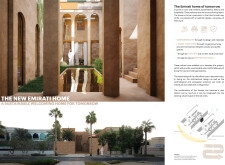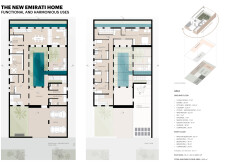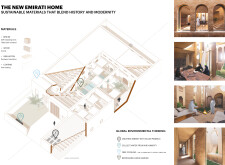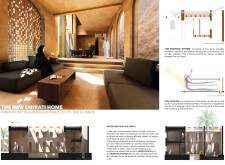5 key facts about this project
### Overview
Located in Jumeirah, Dubai, the New Emirati Home is an architectural design that emphasizes sustainability while reflecting traditional Emirati aesthetics. The project addresses the contemporary need for eco-conscious residential environments that align with cultural values and social structures inherent to Emirati life. By integrating biophilic design principles, the home seeks to establish a blueprint for future living that resonates with both environmental stewardship and historical practices.
### Spatial Organization
The design incorporates a thoughtful spatial strategy that enhances airflow and natural illumination, reinforcing the connection between interior and exterior spaces. The layout features expansive living and dining areas conducive to family gatherings and social interaction. A central pool serves not only as a cooling element but also promotes reflection and tranquility within the environment. Additionally, an oasis garden enhances the overall biophilic design, improving indoor air quality while providing a rich vegetative landscape.
### Technological and Material Considerations
The construction utilizes a range of sustainable materials that merge traditional and contemporary techniques. Self-insulating bricks, filled with rock wool, significantly improve energy efficiency by reducing reliance on artificial heating and cooling systems. Acacia wood is employed for structural components, linking the design to the natural surroundings. A humidity water recovery system, developed in conjunction with architect David Hertz, exemplifies innovative technology that addresses water scarcity by extracting moisture from the air. Complementary features include strategically placed solar panels for renewable energy and a free cooling mechanism that facilitates natural ventilation.






















































